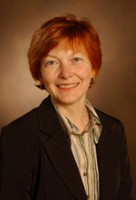
Irina N. Kaverina, Ph.D.
Professor of Cell and Developmental Biology
- : irina.kaverina@vanderbilt.edu
- : (615) 936-5567
- :
552 Engineering and Science Building
2414 Highland Ave
- :
506B Engineering and Science Building
2414 Highland Ave
In our lab, we aim to understand molecular and spatial differences between MT networks in specific cells types, and how these differences promote physiological functions of these cells.
Lab Website
M.S., Moscow Lomonosov State University USSR
Ph.D., Academy of Medical Sciences, Moscow, Russia
Research Description
Architecture of a eukaryotic cell largely depends on microtubules (MTs), 25-nm self-assembling polymers that serve as highways for organelle and molecular transport within a cell. During cell division, MTs drive chromosome segregation. In interphase cells, MTs position organelles and site-specific activities like actin assembly or proteolysis, thereby defining cell shape and polarity. For years, an intriguing question has been how MTs within a cell can perform multiple actions that are spatially and temporally distinct. We think that it can only be possible if functionally distinct subsets exist within the MT network and if these subsets are precisely localized within a cell.
Our lab is interested in:
1) Establishing principles of diversity and asymmetry within MT networks. We study the MT network as a combination of subsets of diverse origin, dynamics and molecular composition. We have recently discovered a novel MT population, which forms at Golgi complex and not at the centrosome. Golgi-derived MTs are molecularly and functionally distinct from the centrosomal MT array. Elucidating their regulation and significance is one of our close goals.
2) Understanding how variations in MT subsets are translated into specifics of cellular architecture and functioning. MTs are essential for organization, shape, polarity and motility of various cell types. MT dependence varies between cell types. We aim to resolve general principles of this regulatory system as well as their cell type-specific tuning essential for distinct cellular phenotypes. Our particular interests are MT-dependent motile properties of normal and cancer cells and MT-dependent organization of contractile actin cytoskeleton in vascular smooth muscle cells.
The astrophysicist Bernard Haisch once said “Advances are made by answering questions. Discoveries are made by questioning answers.” This approach is very appealing to us. Our research is based on a set of dogma-challenging hypotheses that we test through a unique combination of cutting edge high-resolution microscopy techniques supported by molecular and biochemical approaches and merged with mathematical modeling.